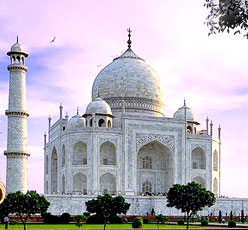Indian architecture is a rich amalgam of various architectural styles, wherein the influences of various regions and dynasties, find due expression. With the Islamic style concentrating only on monuments and the Hindu style being more religious, thematically, Indian architecture, is indeed, a celebration of the creativity of the unsung artisans who dedicated their lives to bring to life such wondrous pieces of enviable beauty. India boasts of a myriad of architectural delights such as the majestic Taj Mahal, the temples of Southern India, the Jain temples and the Buddhist monasteries, to name a few.
Temple Architecture
The Temple Architecture follows the concept of four compartments, namely an entrance porch (the ardhamandap), the vestibule (antarala) and the sanctum (garbhagriha). In some of the large temples an extra mandap with lateral transepts is added for size and splendor, converting it into a large assembly hall.
The Khajuraho temple Located in the forested plains of Madhya Pradesh, in the region known as Bundelkhand is a well-known example of the temple architecture and exquisite sculpture.
Dravidian style of temple architecture is more visible in the numerous temples of Tamil Nadu and Andhra Pradesh. These temples built during the times of enduring peace (southern India had enough of that) are huge in size and some times encompasses entire townships. These temples at the height of their glory were center of all activities of social life and were parallel centers of economic and political powers. Good examples of Dravidian style are temples of Tanjore, Madurai, Mahabalipuram, temples of Badami and Pattadakal, and temples of Kanchipuram.
Moughal Architecture
Before the Islamic elements of architecture were introduced to India, they had already passed through different experimental phases in other countries like Egypt, Iran and Iraq. The Indo-Islamic monuments were typical mortar-masonry works formed of dressed stones unlike most Islamic monuments of these countries, which were largely constructed in brick, plaster and rubble.
Mughal architecture is a characteristic of Indo-Islamic-Persian style that flourished on the Indian subcontinent during the Mughal empire (1526-1857). This new style combined elements of Islamic & Mughal Architecture, which had been introduced to India during the reign of Delhi Sultunate and had produced great monuments such as the Qutub Minar, Red Fort, Humayun Tomb etc having features of Persian art & architecture.
Indo - European Architecture
When the British left India, besides the legacy of language, social customs, the modes of administrative functioning, and more enduringly, their buildings scattered across twenty-four latitudes and widely varied terrain.
A lot of the construction in British India was the work of amateurs and military engineers. Their work reflects a curious adaptation of local materials and weather to a longing for home being expressed in the implantation of European styles in a tropical land. In all of India, apart from Shimla perhaps, it is the city of Bombay, which shows the greatest incorporation of a multitude of divergent styles popular in the Victoria era. The various examples of the indo- European architecture being the Victoria Memorial, From the Fort the Fort area down to the cantonment at Colaba still stand buildings with examples of diverse architectural features such as German gables, Dutch roofs, Swiss timbering, Romance arches and Tudor casements mingled with more ethnic oriental embellishments.
Perhaps the most fitting monuments both in name and splendor, the very symbol of the British in Victorian Bombay is a building that was opened in 1887 in time to celebrate Queen Victoria Terminus or VT. Today it is better known as Chhatrapati Shivaji Terminus.
Monuments of India
Monuments are the backdrop of the world's largest democracy and a slice of India's history in which numerous civilizations flourished.
The exquisite architecture and the intricate embellishments of the Indian monuments represent one of the most prominent facets of the multi-faceted India. An architectural feat in itself, each monument is a strikingly splendid specimen of incredible artistry, shrouding a sense of mystery, intrigue and romance. Be it the marvel in white marble, the unparalleled Taj Mahal, one of the seven wonders of the world; or the red stone splendor, the imposing Red Fort; or the magnificence of temple art of Khajuraho, Konark and Hampi, therein is evident the master craftsmanship and elegance, that brings to the fore the grandeur of the bygone era.
Information on Architecture Heritage tours India, Monuments of India, Moughal Architecture, Temple Architecture, architecture in India, Culture Tourism in India and Cultural Heritage of India.
Travel to India: Cultural & Heritage Tourism: Indian Architecture









